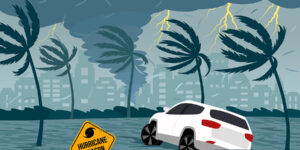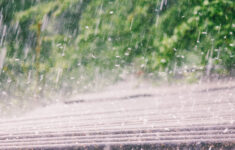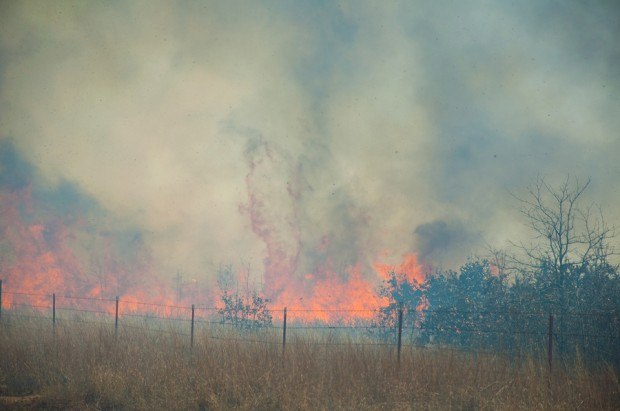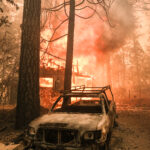When we think of large insured losses arising from natural or manmade disasters, we see images from hurricane or earthquake devastation. First-party property damage and business interruption losses make the headlines.
Executive Summary
Better predictability of certain natural catastrophes is just one of the factors influencing the propensity for casualty claims in the wake of natural disasters. Here Swiss Re’s Jennifer Steven and Daniel Knuesli explain why this is true and discuss other reasons for insurers to think more seriously about casualty claims related to property events.Although we know there are often related casualty claims, we tend to think of these on a secondary basis. Costly events such as the 2007 California wildfires and the 2009 Victoria brushfires have changed our perspective.
There are a growing number of casualty claims stemming from the traditional property claims cluster. While there have been relatively few events, the ones we have seen show a concerning trend, especially for wildfires and floods.
In reviewing the largest casualty losses over the past 10 years, it was interesting to discover that after extracting two well-known casualty loss complexes—pharmaceutical mass tort product liability losses and financial institutions losses—many of the remaining large claims originated from major property events.
This finding led to more questions. What is driving the increase in severity? What about frequency? Is this trend limited to the United States? Which types of natural catastrophes are likely to generate casualty claims? Which policyholders are most likely to face such casualty claims?
There are a growing number of casualty claims stemming from the traditional property claims cluster. Reasons for the trend include:
- Increased frequency of events.
- Higher severity driven by insured values and other factors.
- Changing perception of “acts of God.”
- Increased transparency through use of media/Internet.
- Increased focus of shareholders, analysts and auditors.
- Increased outsourcing and privatization of “governmental” tasks, such as utility and power generation.
Severity
The severity of casualty claims from natural catastrophes in recent years is beyond what the insurance industry had experienced in the past. Two key events that demonstrate this are the 2007 California wildfires and the 2009 brushfires in the Australian state of Victoria.
The California wildfires caused more than $1 billion in casualty losses, and the Victoria brushfires led to casualty losses in excess of $500 million. The main causes of loss for both of these events were alleged negligent actions on the part of utility operators, weather conditions that exacerbated the loss, such as the Santa Ana winds, and intentional human action.
Based on limited data it also appears that the frequency of casualty claims has increased most notably with regard to wildfires.
What is less clear is whether there has been a similar increase in the frequency of casualty claims from other types of property natural catastrophes, such as floods, earthquakes and windstorms.
Interestingly, in the United States, those pursuing casualty claims from flooding suffered a legal setback as a result of the U.S. 5th Circuit Court of Appeals’ September 2012 decision in In Re: Katrina Canal Breaches Litigation, Case No. 10-30249.
However, in Australia, plaintiffs’ counsel involved in filing a class-action suit are expressing optimism about their likelihood of obtaining a significant recovery from the Queensland government due to allegedly negligent operation of the Wivenhoven dam. Estimated insured losses associated with this event are in excess of $300 million so far. Time will tell if the plaintiffs’ optimism is well-founded.
Limited to the United States?
The increases in severity and frequency are not limited to the United States. Australia has seen two of the most severe claims in the past 10 years—the 2009 Victorian brushfires and the 2010 Queensland floods.
We suspect that the most likely locations of these claims will be in countries where flooding, wildfires and windstorms are prevalent and where there is a common law (vs. civil code) legal system in place.
Common law countries include the United States, Canada, the United Kingdom, Australia and New Zealand. Common law countries are well-suited for such lawsuits as they have relatively well-developed mechanisms for compensating those that fund and drive litigation. As collective redress mechanisms are put in place in civil code countries, the propensity for similar suits will also increase.
Types of Natural Catastrophes
Following a large property loss, there is typically an investigation to determine whether or not negligence of a third party caused or contributed to the loss. Subrogation is then pursued, if warranted.
What has not been routine is pursuing third parties including governmental agencies, nongovernmental organizations and major corporations for property losses that occur over a large geographic area and where “nature” is a contributing or leading cause.
Wildfires, in particular, have characteristics that make them more likely to encourage casualty suits. This is because many fires are not started by nature (i.e., a lightning strike) but rather by man—by a spark from a utility line, for example. Man is the initial source of the fire, and nature plays a secondary role in feeding and spreading the fire due to factors such as wind and drought.
Not surprisingly, where man rather than nature can be shown as the initial source of a catastrophe, greater liability is likely to follow.
The predictability and duration of certain natural catastrophes influence the propensity for casualty claims. Weather services are able to predict floods and hurricanes with increasing accuracy and lead time. Therefore the decision-making and mitigation actions of third parties can be more readily questioned.
Earthquakes, in comparison, remain extremely unpredictable and occur with devastating force in a very short time with very little, if any, attribution to the actions of man. As science develops in its ability to link human activity to natural catastrophes there may be a reordering of the types of natural catastrophes that are most likely to result in casualty claims and the industries that are targeted.
Why Increased Frequency and Severity?
Several factors contribute to both increased frequency and severity.
The continuing migration of people to the coasts, particularly in the United States, and the heavy concentration of populations near waterways has led to an increase in insured values in highly exposed areas.
An increase in the construction of expensive homes in more isolated areas also has led to greater wildfire exposure.
The “just-in-time” inventory approach drives higher business-interruption claims, particularly where a large area has been impacted.
Additionally, weather patterns and the conditions they create appear to have become more severe over time and can have the potential to cause greater damage.
Societal changes in the perception of what constitutes an “act of God” is another driver. In many parts of the world, there is a greater willingness to apportion responsibility to corporations, governments and other entities for damage and injury even where nature is a major contributing cause of the catastrophe. Improvements in accident investigation through science make it easier to identify and demonstrate to a judge or jury how man contributed to the catastrophe.
Satellite photos, for example, can be used to help demonstrate where a wildfire originated or exactly where and when a levee was breached. Computers can model how the fire or flood spread or how the damage could have been mitigated.
In the past, governments often bore a significant share of the financial burden resulting from large-area property losses. As many local and national governments are struggling with significant debt burdens, they are no longer willing or able to act as a deep pocket.
Aging infrastructure is also likely to contribute to the frequency of claims. Additionally, there has been a movement toward outsourcing or privatizing many “governmental” tasks, including the monitoring and maintenance of infrastructure.
Governments are generally less vulnerable to third-party claims as they tend to enjoy full or limited immunity, stricter notice requirements and higher proof standards. The U.S. 5th Circuit Court of Appeals’ September 2012 decision in In Re: Katrina Canal Breaches Litigation, Case No. 10-30249, highlights, for instance, some of the special protections enjoyed by the U.S. Army Corps of Engineers. Judges and juries seem to recognize an award against a governmental entity as an award against society at large. However, to the extent that governmental tasks are outsourced or privatized to corporations, these companies do not enjoy the same protections.
The use of social media and the Internet are factors that have impacted both the frequency and severity of claims in that their use facilitates the ability to identify and recruit potential plaintiffs at a much lower cost than in the past.
Which Policyholders Are Most Susceptible to Such Claims?
Based on some of the larger losses recorded, there are some industries that appear more vulnerable than others. Utilities and railroads are particularly vulnerable to wildfire claims as are the companies that help them maintain their systems and right of ways. This is because their operations could be the source of an initial fire and because they operate over a vast geographic area.
Additionally, these are large entities with significant financial resources that make them attractive defendants.
The industry has also seen significant casualty claims relating to wildfires brought against construction companies building or maintaining roadways and overpasses.
Utilities or other entities that act as dam operators are likely to face scrutiny in connection with how they respond to flooding events. Companies that are charged with maintaining or building flood defenses are also potential targets of casualty suits.
Following Hurricane Sandy, utility companies were exposed based on storm response and time to restore service to customers. Yet to fully play out is how much of the estimated $25 billion of losses associated with Sandy will be attributed to casualty.
A Trend Worth Keeping an Eye On
The trend of casualty claims stemming from large-area property losses is worth watching in terms of both frequency and severity, and it should be considered in underwriting certain individual risks and portfolios.
It’s not just a question of what pocket the payment of the loss is coming from. In the case of a property insurer, the company may recover part or all of its loss payment after prevailing on a subrogation claim. When casualty claims are involved, the costs and losses incurred by individuals, companies, NGOs and governments that were not covered by or exceeded first-party cover are being pursued and, at least in part, are awarded or recovered in the resolution of the suits.





















 Survey Finds More Employees Bringing Their Own AI to Work
Survey Finds More Employees Bringing Their Own AI to Work  Reserve Strengthening for Casualty Lines Not Over: Moody’s
Reserve Strengthening for Casualty Lines Not Over: Moody’s  Catastrophe Bonds Use Models Underestimating Climate Risks, Investors Say
Catastrophe Bonds Use Models Underestimating Climate Risks, Investors Say  Berkshire Wary of “Fashionable’ Cyber Insurance, AI
Berkshire Wary of “Fashionable’ Cyber Insurance, AI 
























